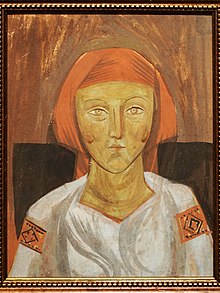| Revision as of 11:26, 25 March 2024 edit Arthistorian1977 (talk | contribs)Autopatrolled, Extended confirmed users, New page reviewers20,772 edits Created by translating the page "Бойчукизм"Tags: nowiki added ContentTranslation ContentTranslation2Next edit → |
| (No difference) |
Revision as of 11:26, 25 March 2024

Boychukism is a cultural and artistic phenomenon in the history of ] of 1910-1930s, distinguished by its artistic monumental-synthetic style.
The basis of Boychuk’s concept of the development of new art was an appeal to the traditions of Byzantine and Italian monumental painting, as well as ancient Russian icon painting, as the primary source of the Ukrainian national form.
The name comes from the name of the founder of the movement: Mikhail Boychuk, a muralist and graphic artist.
At the end of 1925, the Association of Revolutionary Art of Ukraine (ARIU) was founded in Kyiv, uniting Boychukists.
Gallery
-
 Shevchenko holiday, Mikhail Boychuk, 1920
Shevchenko holiday, Mikhail Boychuk, 1920
-
 M. Padalka. Sketch of an illustration for “The Tale of Igor’s Campaign,” 1928.
M. Padalka. Sketch of an illustration for “The Tale of Igor’s Campaign,” 1928.
-
 Sedlyar, Vasily Teofanovich, “At the school of educational programs”, the limit of the 1920-1930s.
Sedlyar, Vasily Teofanovich, “At the school of educational programs”, the limit of the 1920-1930s.
-
 Shekhtman, Manuil Iosifovich “Jewish pogrom”, 1926.
Shekhtman, Manuil Iosifovich “Jewish pogrom”, 1926.
-
 L. Lozovsky. Illustration, “Instead of sonnets and octaves”, Tychina, Pavel Grigorievich, 1920
L. Lozovsky. Illustration, “Instead of sonnets and octaves”, Tychina, Pavel Grigorievich, 1920
-
 Nalepinskaya-Boychuk, Sofya Alexandrovna, “Girls with a book”, 1927
Nalepinskaya-Boychuk, Sofya Alexandrovna, “Girls with a book”, 1927
-
 Mezhyhirya nativity scene, 1923
Mezhyhirya nativity scene, 1923